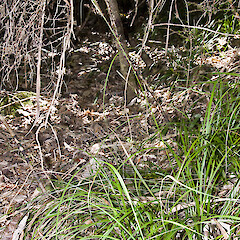Carex spinirostris
Common name
coastal sedge, petrel scrub sedge
Synonyms
Carex cinnamomea Cheesman.; Carex forsteri Wahl. var. cockayniana (Kük.) Kük.
Family
Cyperaceae
Flora category
Vascular – Native
Endemic taxon
Yes
Endemic genus
No
Endemic family
No
Structural class
Sedges
NVS code
The National Vegetation Survey (NVS) Databank is a physical archive and electronic databank containing records of over 94,000 vegetation survey plots - including data from over 19,000 permanent plots. NVS maintains a standard set of species code abbreviations that correspond to standard scientific plant names from the Ngä Tipu o Aotearoa - New Zealand Plants database.
CARSPI
Chromosome number
2n = 60-66
Current conservation status
The conservation status of all known New Zealand vascular plant taxa at the rank of species and below were reassessed in 2017 using the New Zealand Threat Classification System (NZTCS) – more information about this can be found on the NZTCS website. This report includes a statistical summary and brief notes on changes since 2012 and replaces all previous NZTCS lists for vascular plants.
Please note, threat classifications are often suggested by authors when publications fall between NZTCS assessment periods – an interim threat classification status has not been assessed by the NZTCS panel.
- Conservation status of New Zealand indigenous vascular plants, 2017 . 2018. Peter J. de Lange, Jeremy R. Rolfe, John W. Barkla, Shannel P. Courtney, Paul D. Champion, Leon R. Perrie, Sarah M. Beadel, Kerry A. Ford, Ilse Breitwieser, Ines Schönberger, Rowan Hindmarsh-Walls, Peter B. Heenan and Kate Ladley. Department of Conservation. Source: NZTCS and licensed by DOC for reuse under the Creative Commons Attribution 4.0 International licence.
2017 | Not Threatened
Previous conservation statuses
2012 | Not Threatened
2009 | Not Threatened
2004 | Not Threatened
Distribution
Endemic. North Island from Te Paki south to the Horowhenua and Wairarapa. Most common in northern part of range, particularly along the coast and on many of the Hauraki Gulf islands.
Habitat
Favouring coastal to lowland forest, usually in semi-shaded sites on banks, colluvium or gently sloping sites overlying free draining, fertile soils. Also a conspicuous sedge of offshore islands inthe Hauraki Gulf where it is one of the main species found under forest within petrel colonies.
Detailed description
Densely caespitose, tufted, dark green sedge of high fertility sites in shaded coastal forest, lowland forest and forested offshore islands (especially within petrel colonies). Culms 0.1–1.2 m × 1.5–2 mm; basal sheaths dark red-purple. Leaves equal to or great than culms, 2.5–6 mm wide, double-folded, with keel and margins distinctly scabrid. Inflorescence of 4–6–8 spikes; terminal spike male, often compound, with female flowers intermixed in the secondary spikes; remaining spikes female with a few male flowers at the base, equal to or slightly longer than male spikes, 15–85–(100) × 3–4 mm, uppermost spikes closet set, shortly pedunculate, lowermost spikes rather distant, drooping on slender filiform peduncles; subtending bracts leaf-like, much longer than inflorescence, almost the same width as foliage leaves. Glumes equal to or slightly than utricles in length, bright red-purple, rather membranous, deciduous, lanceolate, subacute to almost emarginated, midrib extended as a long scabrid awn. Utricles 3–4 × 1 mm, triquetrous, fusiform, conspicuously ribbed with pale veins, margins smooth, pale grey below, above bright red and narrowed (often rather abruptly) to a 1.5 mm long beak; crura scabrid; stipe 0.5 mm long. Stigmas 3. Nut 2 mm long, yellow, yellow-brown or rarely light brown, oblong, trigonous.
Similar taxa
Closely allied to Carex ophiolithica de Lange et Heenan from which it differs by its ecology, non-bulbous culm bases, drooping culms, dense tussock-forming habit, dark red-brown to purple-brown basal sheaths, distinctly pendulous spikelets, bright red-purple glumes, red to red-brown mature utricles, and yellow, yellow-brown or rarely light brown, oblong, trigonous, smaller nut. Carex ophiolithica is a smaller sedge of open coastal ultramafic cliff, scree, boulder field, and low scrub with bulbous culm bases, erect culms, erect, very shortly pedunculate spikes, light green to pale brown glumes, pale brown to purple brown glumes, and a larger ovoid, trigonous, dark brown to grey brown nut.
Flowering
August–October
Fruiting
September–March
Life cycle
Nuts surrounded by inflated utricles are dispersed by granivory and wind (Thorsen et al., 2009).
Propagation technique
Easily grown from the division of whole plants and from fresh seed. Does best in free draining, fertile soils in semi-shade. An attractive sedge well worth cultivating.
Etymology
carex: Latin name for a species of sedge, now applied to the whole group.
Where To Buy
Not commercially available
Attribution
Fact Sheet prepared by P.J. de Lange (10 August 2006). Description adapted from Moore and Edgar (1970)
References and further reading
Moore LB, Edgar E. 1970. Flora of New Zealand, Volume II. Indigenous Tracheophyta: Monocotyledones except Gramineae. Government Printer, Wellington, NZ. 354 p.
Thorsen MJ, Dickinson KJM, Seddon PJ. 2009. Seed dispersal systems in the New Zealand flora. Perspectives in Plant Ecology, Evolution and Systematics 11: 285–309.
NZPCN Fact Sheet citation
Please cite as: de Lange, P.J. (Year at time of access): Carex spinirostris Fact Sheet (content continuously updated). New Zealand Plant Conservation Network. https://www.nzpcn.org.nz/flora/species/carex-spinirostris/ (Date website was queried)






